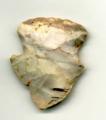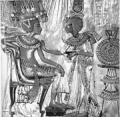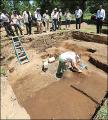- 08 JUILLET :
- ITALIE :  A Copper Age tribe may have enjoyed a primitive cinematic experience by making stone engravings in an echo-filled Alpine valley, researchers say. Torchlight and flickering shadows would have made the engravings on stone walls seem to come alive at night. And spoken words that became magnified in a natural outdoor theater could have awakened the storytelling imaginations of observers.
A Copper Age tribe may have enjoyed a primitive cinematic experience by making stone engravings in an echo-filled Alpine valley, researchers say. Torchlight and flickering shadows would have made the engravings on stone walls seem to come alive at night. And spoken words that became magnified in a natural outdoor theater could have awakened the storytelling imaginations of observers.
http://www.livescience.com/history/primitive-cinema-used-echoes-and-rock-engravings-100708.html
- ROYAUME-UNI :  Happisburgh - Une étude sur des découvertes archéologiques britanniques a permis de découvrir que l'homme a occupé la Grande-Bretagne il y a plus de 800.000 ans, soit 100.000 ans plus tôt que ce que les scientifiques pensaient jusqu'alors. 78 outils et éclats de silex découverts près de Happisburgh, dans le comté de Norfolk, à l’Est du pays, ont révélé un présence humaine en Europe du Nord plus ancienne que ce qui était jusque là jugé possible. Le site est alors devenu la plus ancienne implantation connue dans le nord de l'Europe.
Happisburgh - Une étude sur des découvertes archéologiques britanniques a permis de découvrir que l'homme a occupé la Grande-Bretagne il y a plus de 800.000 ans, soit 100.000 ans plus tôt que ce que les scientifiques pensaient jusqu'alors. 78 outils et éclats de silex découverts près de Happisburgh, dans le comté de Norfolk, à l’Est du pays, ont révélé un présence humaine en Europe du Nord plus ancienne que ce qui était jusque là jugé possible. Le site est alors devenu la plus ancienne implantation connue dans le nord de l'Europe.
http://www.maxisciences.com/humain/grande-bretagne-decouverte-des-plus-anciennes-traces-humaines-d-039-europe-du-nord_art8289.html
- U.S.A. :  Ohio - The 77-year-old Reynoldsburg man has been in a three-year battle with the Historical Society to recover an artifact he found as a boy - a piece of pre-history from the Early Woodland Adena culture that was probably created 400 years or more before the birth of Christ.
Ohio - The 77-year-old Reynoldsburg man has been in a three-year battle with the Historical Society to recover an artifact he found as a boy - a piece of pre-history from the Early Woodland Adena culture that was probably created 400 years or more before the birth of Christ.
http://www.dispatch.com/live/content/local_news/stories/2010/07/08/fight-over-boyhood-treasure.html?sid=101
- AUSTRALIE :  Experts are divided over whether a huge gallery of ancient Aboriginal rock art in Western Australia is withstanding the effect of industry in the area. The debate comes with the release of recent studies on the heritage-listed Burrup Peninsula petroglyphs (rock engravings) presented today at the Australian Earth Sciences Convention in Canberra.
Experts are divided over whether a huge gallery of ancient Aboriginal rock art in Western Australia is withstanding the effect of industry in the area. The debate comes with the release of recent studies on the heritage-listed Burrup Peninsula petroglyphs (rock engravings) presented today at the Australian Earth Sciences Convention in Canberra.
http://www.abc.net.au/science/articles/2010/07/08/2947012.htm
- TURQUIE : Eceabat - Executives with the Çanakkale Archeological Museum launched excavations at the ancient city of Madytos in Canakkale's Eceabat town in order to declare new archeological protection sites. Excavation team has unearthed remains of architectural buildings dating to late Byzantine and Ottoman eras, graves, coins and ceramics. The first settlement in what is now Eceabat was founded by the Thracians, a Balkan people. Later the settlement became known as Madytos and later as Madytos and received migrants coming from Foca (Phokai), Miletos and Midilli Island (Lesbos).
http://www.todayszaman.com/tz-web/news-215461-100-excavations-begin-at-ancient-city-in-western-turkey.html
- EGYPTE :  Marriage and family were the core of ancient Egyptian society, and their practice of early marriage stemmed from their belief that a committed and happy family would lead to secure and contented children who would be the future adults of a stable society. Legal documents show clearly that married men and women had well-defined responsibilities. The bride might bring with her into the marriage domestic equipment, textiles and sometimes a donkey -- the main means of transport at the time. The groom built the house and gave his wife commodities and items of jewellery.
Marriage and family were the core of ancient Egyptian society, and their practice of early marriage stemmed from their belief that a committed and happy family would lead to secure and contented children who would be the future adults of a stable society. Legal documents show clearly that married men and women had well-defined responsibilities. The bride might bring with her into the marriage domestic equipment, textiles and sometimes a donkey -- the main means of transport at the time. The groom built the house and gave his wife commodities and items of jewellery.
http://weekly.ahram.org.eg/2010/1006/he1.htm
- SYRIE :  Musical scholar Ziad Ajjan composed eight poetry and musical pieces from the musical archaeological cuneiform tablet known as "Hymn of Supplication" H6 discovered in Ugarit in the early 20th century. Ajjan composed three musical pieces based on the musical notes in the tablet which dates back to 1400 BC, naming the pieces "Sunrise," "Sunset" and "Holiday in Ugarit."This marks the recording of the oldest music notation in the history of the world.
Musical scholar Ziad Ajjan composed eight poetry and musical pieces from the musical archaeological cuneiform tablet known as "Hymn of Supplication" H6 discovered in Ugarit in the early 20th century. Ajjan composed three musical pieces based on the musical notes in the tablet which dates back to 1400 BC, naming the pieces "Sunrise," "Sunset" and "Holiday in Ugarit."This marks the recording of the oldest music notation in the history of the world.
http://www.english.globalarabnetwork.com/201007076478/Entertainment/syria-scholar-composes-music-from-archaeological-ugaritic-cuneiform-tablet.html
- ROYAUME-UNI :  Frome - The largest single hoard of Roman coins ever found in Britain has been unearthed on a farm near Frome in Somerset. A total of 52,500 bronze and silver coins dating from the 3rd century AD – including the largest ever found set of coins minted by the self proclaimed emperor Carausius, who lasted seven years before he was murdered by his finance minister – were found by Dave Crisp, a hobby metal detectorist from Devizes, Wiltshire. How they got into the field remains a mystery, but archaeologists believe they must represent the life savings of an entire community – possibly a votive offering to the gods. A Roman road runs nearby, but no trace of a villa, settlement or cemetery has been found.
Frome - The largest single hoard of Roman coins ever found in Britain has been unearthed on a farm near Frome in Somerset. A total of 52,500 bronze and silver coins dating from the 3rd century AD – including the largest ever found set of coins minted by the self proclaimed emperor Carausius, who lasted seven years before he was murdered by his finance minister – were found by Dave Crisp, a hobby metal detectorist from Devizes, Wiltshire. How they got into the field remains a mystery, but archaeologists believe they must represent the life savings of an entire community – possibly a votive offering to the gods. A Roman road runs nearby, but no trace of a villa, settlement or cemetery has been found.
http://www.guardian.co.uk/science/2010/jul/08/hoard-roman-coins-somerset
- CONGO : VIDEO - Un archéologue au Congo . Il arpente le Bas Congo à la recherche des sites d'art rupestre.
http://www.lemonde.fr/afrique/visuel/2010/07/08/un-archeologue-au-congo_1384916_3212.html#xtor=RSS-3208
- 07 JUILLET :
- FRANCE : Narbonne - Les fouilles archéologiques préalables à un chantier, menées sur trois sites distincts entre le domaine Saint-Félix et l'aire de Vinassan, ont permis de mettre au jour les vestiges d'un habitat important et de tombes, tous datés du haut Moyen-Âge. Les fouilles montrent que le site a été occupé au début de la présence romaine, à l'Antiquité et au Moyen-Âge avec un prolongement avec la grande bastide présente sur place.
http://www.midilibre.com/articles/2010/07/07/NARBONNE-Decouverte-archeologique-rare-lors-des-fouilles-1298311.php5
- U.S.A. :  Pig Point - the county archaeological dig in south county awash in ancient Native American artifacts, drew the interest of an international group of antiquities-minded officials Friday. With three huge pits being excavated and a wigwam built to scale like the ones the Lost Towns Project found evidence of last year, Pig Point was just the spot. Luckenbach showed off several of the more than 150,000 artifacts culled so far from Pig Point, including some indicating human activity at the site as long as 10,000 years ago. The wigwam evidence uncovered last year was approximately 800 years old. Carbon dating pegged wigwam post molds found later to be from the sixth and third centuries A.D.
Pig Point - the county archaeological dig in south county awash in ancient Native American artifacts, drew the interest of an international group of antiquities-minded officials Friday. With three huge pits being excavated and a wigwam built to scale like the ones the Lost Towns Project found evidence of last year, Pig Point was just the spot. Luckenbach showed off several of the more than 150,000 artifacts culled so far from Pig Point, including some indicating human activity at the site as long as 10,000 years ago. The wigwam evidence uncovered last year was approximately 800 years old. Carbon dating pegged wigwam post molds found later to be from the sixth and third centuries A.D.
http://www.hometownannapolis.com/news/top/2010/07/07-46/International-group-digs-Pig-Point.html
- DANEMARK :  Bog bodies : the famous Tullund Man and the Queen of the Bog. he Tullund Man was found in a bog in Denmark in 1950. He was considered to be over 2,000 years old. However, most bodies found in bogs date back to the Iron Age. The Tullund Man at first glance looked like he had just died a few days before discovery. There was a rope around his neck and archeologists believe that he was a sacrifice to the fertility goddesses. He was hanged and then thrown into the bog. The Haraldskaer Woman was found in Gunnelsmose, Denmark in 1835. It was once believed she was Gunhild the Norwegian Queen who lived around 1000 A.D. The Danish king Harald Blatand (Blue Tooth), had her killed and then thrown in the bog.
Bog bodies : the famous Tullund Man and the Queen of the Bog. he Tullund Man was found in a bog in Denmark in 1950. He was considered to be over 2,000 years old. However, most bodies found in bogs date back to the Iron Age. The Tullund Man at first glance looked like he had just died a few days before discovery. There was a rope around his neck and archeologists believe that he was a sacrifice to the fertility goddesses. He was hanged and then thrown into the bog. The Haraldskaer Woman was found in Gunnelsmose, Denmark in 1835. It was once believed she was Gunhild the Norwegian Queen who lived around 1000 A.D. The Danish king Harald Blatand (Blue Tooth), had her killed and then thrown in the bog.
http://www.gather.com/viewArticle.action?articleId=281474978350247
- MYANMAR : Doing archaeological research on the Myanmar history from the origin of the race to date through the prehistoric period and Pyu period, Myanmar claimed that migrated from one place to another in the Myanmar soil along with the Myanmar civilization. In 2009, Myanmar found some more evidences on both Bronze Age and Iron Age after excavating areas in Thazi township, central Mandalay division, proving that Myanmar passed through both Bronze Age and Iron Age in the ancient time.
http://news.xinhuanet.com/english2010/sci/2010-07/07/c_13388000_2.htm
- ITALIE :  A sandstone sculpture of a kneeling man sharpening a knife could be a long forgotten work by Michelangelo, according to an Italian scholar who has rediscovered the statue in a private collection. The powerful sculpture is a copy of a marble statue known as the “Arrotino” (the Blade-Sharpener) on display at the Uffizi gallery in Florence. Representing the Scythian slave who served Apollo and flayed the satyr Marsyas, the Uffizi sculpture is itself a Roman copy from a lost Hellenistic original.
A sandstone sculpture of a kneeling man sharpening a knife could be a long forgotten work by Michelangelo, according to an Italian scholar who has rediscovered the statue in a private collection. The powerful sculpture is a copy of a marble statue known as the “Arrotino” (the Blade-Sharpener) on display at the Uffizi gallery in Florence. Representing the Scythian slave who served Apollo and flayed the satyr Marsyas, the Uffizi sculpture is itself a Roman copy from a lost Hellenistic original.
http://news.discovery.com/history/long-lost-michelangelo-sculpture-found.html
- ROYAUME-UNI : VIDEO - Archaeologists digging on a Norfolk beach found stone tools that show the first humans were living in Britain much earlier than previously thought. A spectacular haul of ancient flint tools has been recovered from a beach in Norfolk, pushing back the date of the first known human occupation of Britain by up to 250,000 years. While digging along the north-east coast of East Anglia near the village of Happisburgh, archaeologists discovered 78 pieces of razor-sharp flint shaped into primitive cutting and piercing tools. The stone tools were unearthed from sediments that are thought to have been laid down either 840,000 or 950,000 years ago, making them the oldest human artefacts ever found in Britain.
http://www.guardian.co.uk/science/2010/jul/07/first-humans-britain-stone-tools
- ETHIOPIE :  Garima - Des nouvelles techniques de datations ont révélé qu'un manuscrit supposé avoir été écrit au XIème siècle daterait en réalité d'entre 330 et 650 après Jésus-Christ. Selon la légende, c'est après avoir fondé le monastère de Garima au Vème siècle que le moine Abba Garima recopia en une seule journée les évangiles qui composent le manuscrit qui porte son nom. Le livre contient ainsi des illustrations des récits des apôtres Mathieu, Jean, Marc et Luc et ce qui pourrait être la première illustration chrétienne : le Temple des Juifs. Le manuscrit sacré qui aurait des vertus magiques a depuis été précieusement conservé et n'a jamais quitté le monastère.
Garima - Des nouvelles techniques de datations ont révélé qu'un manuscrit supposé avoir été écrit au XIème siècle daterait en réalité d'entre 330 et 650 après Jésus-Christ. Selon la légende, c'est après avoir fondé le monastère de Garima au Vème siècle que le moine Abba Garima recopia en une seule journée les évangiles qui composent le manuscrit qui porte son nom. Le livre contient ainsi des illustrations des récits des apôtres Mathieu, Jean, Marc et Luc et ce qui pourrait être la première illustration chrétienne : le Temple des Juifs. Le manuscrit sacré qui aurait des vertus magiques a depuis été précieusement conservé et n'a jamais quitté le monastère.
http://fr.news.yahoo.com/55/20100707/tod-un-manuscrit-dcouvert-en-ethiopie-po-17baed7.html